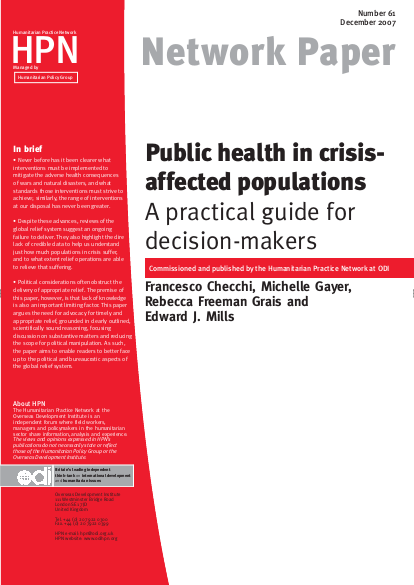A Practical Guide for Decision-Makers

This paper attempts to present a bird’s eye view of the
risks to health inherent in crises, and the potential for
impact of health interventions, using the language of
epidemiology.
Which crises?
We restrict ourselves to the following five crisis conditions,
brought about by war and/or natural disasters:
• Condition 1: Progressive loss of livelihoods and
deterioration of essential services, with entrapment in
one’s community due to the ever-present risk of
violence. Examples of this condition could be the
eastern Democratic Republic of Congo (DRC), eastern
Chad, regions of Nepal affected by the Maoist
insurgency, western Côte d’Ivoire and Iraq.
• Condition 2: Mass displacement into regimented or
camp-like settlements of large population size. This is
the classic relief scenario (think of IDP camps in Darfur
and northern Uganda, or refugee camps on the
Thai–Burma border).
• Condition 3: Displacement into neighbouring host
communities. Examples include Lebanese IDPs during
the 2006 Israel–Hezbollah war, and Sri Lankans
displaced by recent fighting. This displacement may be
directly due to violence, but could also occur indirectly
due to loss of livelihoods and social pressures: Burma
is a prime example of this.
• Condition 4: Sudden loss of livelihoods and rapid
environmental change (including flooding) due to a
natural disaster. Major examples are the Indian Ocean
tsunami of 2004 and the Pakistan earthquake of 2005.
• Condition 5: Food crises. Examples include Niger in
2005–2006 and the famine in the Somali region of
Ethiopia in 2000.